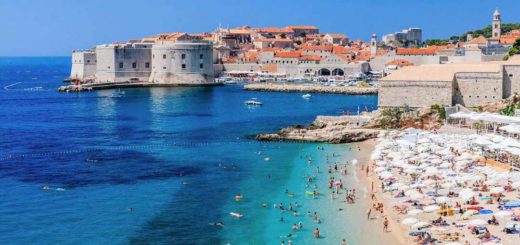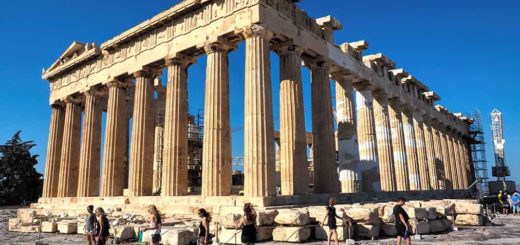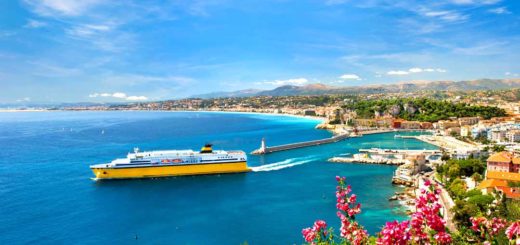Madrid
Madrid is Spain’s capital and is the Iberian Peninsula’s largest city, and is the 6th most livable city in the world (as of 2023). The city is in the heart of Spain and is relatively small with a population of 3.2 million people.

The climate in the city is said to be the continental Mediterranean where summers are hot, especially during July and August with average temperatures above 24°C (75°F). Winters are cool with an average temperature below 6°C (43°F) and frosts and snowfalls are usually observed during this season.
Located on its western portion is the Sierra de Guadarrama, with Peñalara as Madrid’s highest mountain at 2,428m (7,966ft) above sea level. The eastern side of the mountain is located in the municipality of Rascafría and its western side is located in the province of Segovia.
Retiro Park
Retiro Park, or Parque del Retiro, truly embodies the essence of its name, “Park of the Pleasant Retreat.” This lush oasis in the heart of Madrid offers a peaceful escape from the urban hustle, a privilege once reserved exclusively for Spanish royalty until the 19th century. Today, as one of Madrid’s largest parks, Retiro’s regal past is reflected in its elegant gardens, majestic sculptures, and romantic vistas that invite visitors into a world of tranquility and beauty.
Wander through its meticulously landscaped gardens, where white statues stand sentinel among blooming flowers, and discover the grand monument to Alfonso XII, which presides over a vast pond. Here, you are encouraged to embark on a leisurely boat ride, creating your own moment of peace amidst the gentle waters. Not to be missed is the Crystal Palace, a dazzling structure that captures the imagination and offers a serene backdrop for relaxation. Retiro Park is not just a park; it’s a sanctuary within the city, offering a serene retreat where memorable afternoons are spent immersed in nature’s embrace, a stone’s throw away from the vibrant life of Madrid.
Plaza Mayor
Plaza Mayor stands as a testament to the rich tapestry of Madrid’s history, positioned at the heart of Old Madrid. Constructed in the late 1500s, this expansive square encapsulates the essence of Spanish architectural grandeur and has long been a focal point of city life. Dominating the center of the plaza is the striking bronze equestrian statue of Philip III, erected in 1616, which adds a regal touch to the already impressive surroundings.
Upon entering Plaza Mayor, you are immediately transported into a different era, enveloped by an open rectangular space that is flanked on all sides by buildings adorned with period architecture. The plaza is a vibrant hub of activity, frequently hosting an array of events that could range from bustling markets to lively football games and captivating public exhibitions.
Spending an afternoon in Plaza Mayor offers an unparalleled opportunity to immerse yourself in the local culture. Whether you’re indulging in a photography session, browsing through the quaint shops, savoring delights from the popular Bakery House, or simply basking in the sun while people-watching, Plaza Mayor provides a picturesque backdrop for creating unforgettable memories. It’s a place where the past and present converge, offering a slice of Madrid’s soul to all who visit.
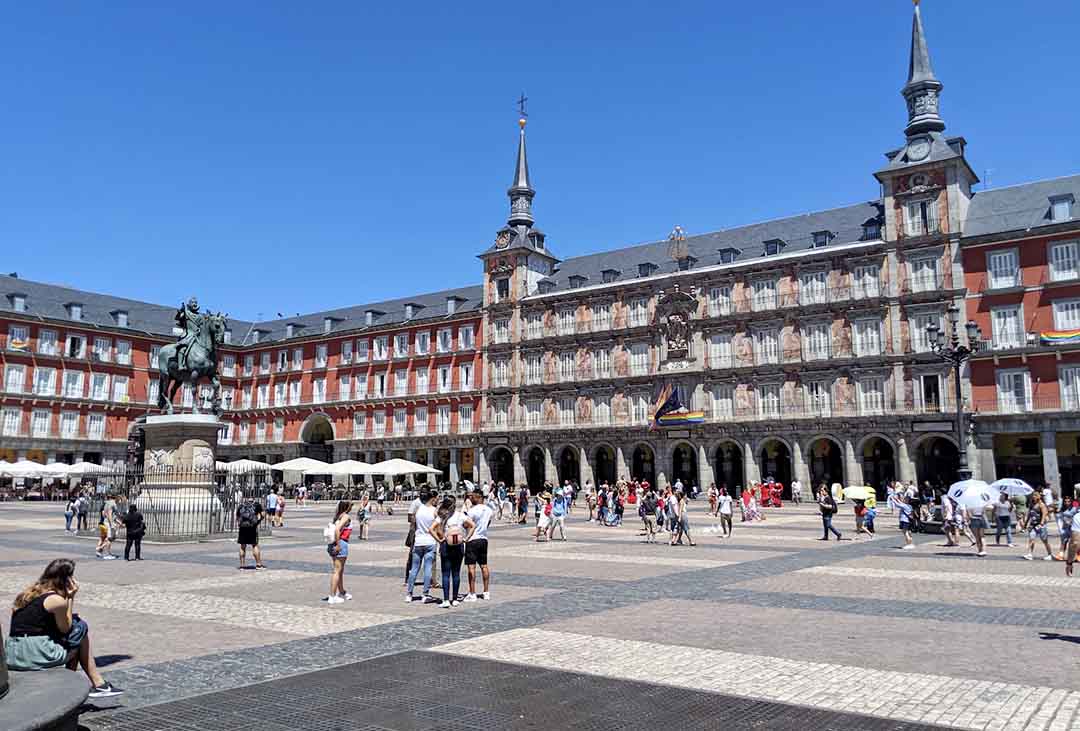
Plaza de Cibeles
Plaza de Cibeles is not just a mere intersection in Madrid; it’s the beating heart of the city, where the grand Paseo del Prado and Calle Alcalá converge. This iconic square encapsulates the essence of Madrid, embodying the city’s vibrant spirit and architectural magnificence.
At its core stands the majestic Cibeles Fountain, a homage to Cybele, the Phrygian goddess of fertility. Sculpted with exquisite detail, the goddess is depicted in a chariot, drawn by two powerful lions, symbolizing the city’s strength and resilience. Surrounding the fountain are some of Madrid’s most significant buildings, each telling its own story of the city’s rich heritage.
Among these architectural marvels are the Banco de España (Bank of Spain), showcasing the country’s financial history; the Palacio de Linares, a beacon of cultural and artistic excellence; and the Palacio de Cibeles, a stunning example of Madrid’s urban sophistication. Together, they frame the Plaza de Cibeles, making it a grandiose spectacle of art and architecture.
Visiting Plaza de Cibeles offers more than just a visual feast; it’s a journey through Madrid’s symbolic heart. Whether you’re marveling at the intricate designs of its monuments, soaking in the atmosphere of its bustling surroundings, or simply enjoying a moment of reflection by the fountain, Plaza de Cibeles is a must-visit destination that captures the soul of Madrid. Make sure to include this iconic square in your itinerary to experience the true essence of the city before you depart.
La Puerta del Sol stands as the pulsating heart of Madrid, a vibrant square that not only occupies the central point of the city but also embodies its spirit and energy. This square is more than just a geographical marker; it’s a place where history, culture, and modern-day festivities converge, offering a unique glimpse into the life of Madrid.
Since 1962, Puerta del Sol has hosted the city’s exuberant New Year’s Eve celebrations, drawing comparisons to the iconic Times Square in New York. Crowds gather here annually, eyes fixed on the historic clock that marks the beginning of the new year. As the clock strikes midnight, the tradition of eating twelve grapes—one for each chime—brings together families and friends in a shared moment of hope and joy for the year ahead.
But the significance of Puerta del Sol extends beyond contemporary celebrations. Once a 15th-century gateway that fortified Madrid, today it is a testament to the city’s evolution, seamlessly integrating its rich history with the dynamism of modern life. The square is adorned with statues, notable buildings, and landmarks that pay homage to Madrid’s past, while bustling shops and eateries cater to the tastes and needs of both locals and visitors alike.
Puerta del Sol is not just a destination; it’s an experience. Whether you’re soaking in the architectural beauty, indulging in local cuisine, or simply people-watching, this square offers a panoramic view of Madrid’s soul. It’s a place where every corner holds a story, every street echoes with laughter, and every visit leaves you with unforgettable memories. When in Madrid, Puerta del Sol is an essential stop to truly understand and feel the heartbeat of this magnificent city.
Reina Sofia National Museum
The Reina Sofia National Museum stands as a beacon of 20th-century art, boasting Spain’s finest collection of contemporary masterpieces. This prestigious museum is not just a gallery; it’s a journey through the tumultuous and transformative periods of the 20th century, as seen through the eyes of Spanish and international artists alike.
The museum’s treasures are thoughtfully divided into three main collections, each representing a distinct era of artistic evolution and historical context. “The Irruption of the 20th Century: Utopias and Conflicts (1900-1945)” delves into the early upheavals and idealistic visions that defined the first half of the century. “Is the War Over? Art in a Divided World (1945-1968)” captures the post-war era, marked by division, reflection, and the quest for new meanings. “From Revolt to Postmodernity (1962-1982)” explores the shifts towards modernist and postmodernist expressions, highlighting the dynamic changes in art and society up to the early 1980s.
Beyond its permanent collections, the Reina Sofia National Museum is also a vibrant platform for national and international exhibitions. These temporary showcases provide a fresh and contemporary perspective on various artistic movements, offering visitors an opportunity to engage with the ever-evolving landscape of modern art. Whether you’re a connoisseur of contemporary art or simply curious about the artistic milestones of the 20th century, the Reina Sofia National Museum invites you on an enlightening exploration of creativity, conflict, and change.
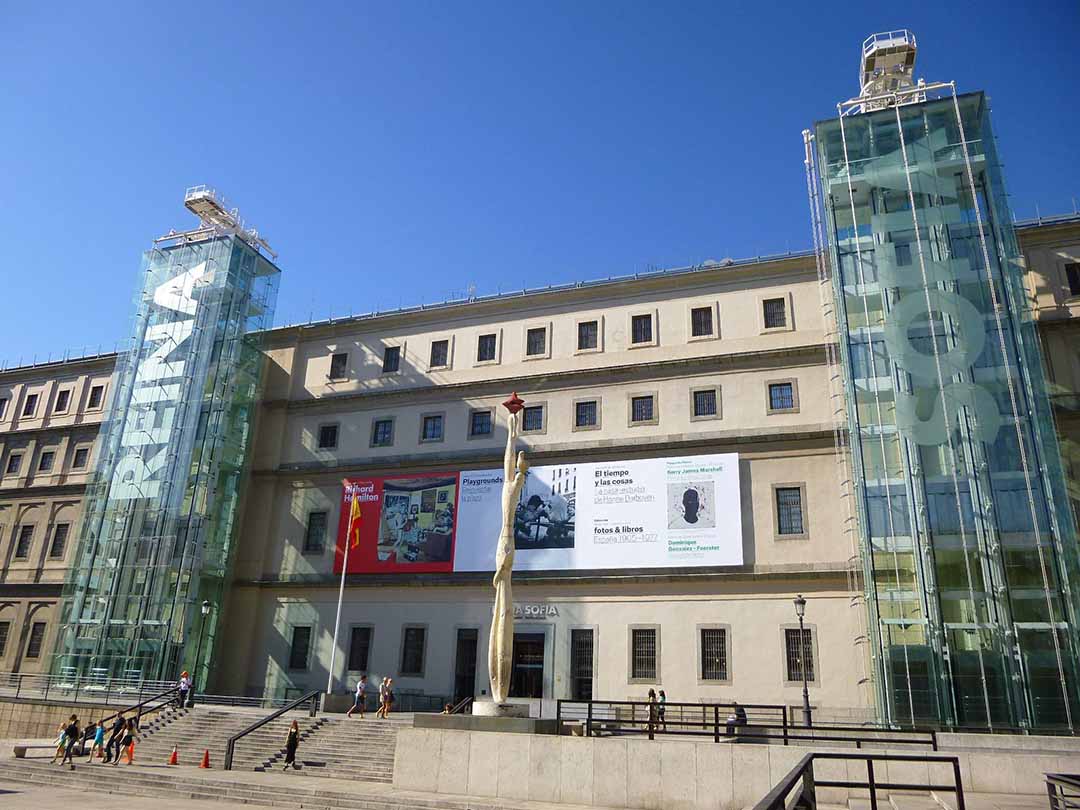
Prado Museum
The Prado Museum is not just Spain’s premier national art museum; it’s a treasure trove of the world’s most awe-inspiring art collections, showcasing an unparalleled example of Spanish art and heritage at its finest. This iconic museum serves as a custodian of a rich tapestry of artistic expression, spanning painting, sculpture, decorative arts, and drawings, each piece narrating its own story of creativity, tradition, and historical significance.
Visitors to the Prado Museum are offered three meticulously curated routes, designed to guide them through an immersive exploration of the museum’s masterpieces. This thoughtful organization ensures that each guest can fully appreciate the breadth and depth of the collections on display, making their journey through the museum not just a walk but an enlightening voyage through time.
Embarking on this journey offers a unique opportunity to delve into Spanish culture and history as seen through the lens of its most celebrated artists. From the vibrant hues of El Greco to Velázquez’s intricate portraits, and Goya’s profound commentaries on society, the Prado Museum encapsulates the essence of Spanish artistry. It’s a place where the past converses with the present, inviting visitors to engage with the art and stories that have shaped Spain and the world beyond.
Whether you’re an art aficionado or a curious traveler, the Prado Museum promises an enriching experience, offering insights into the soul of Spain through its magnificent collections. It stands as a testament to the power of art to educate, inspire, and connect us to the wider narratives of history and culture.
Mercado San Miguel
Just a stone’s throw from Plaza Mayor, the Mercado San Miguel awaits as a must-visit destination for anyone looking to immerse themselves in Madrid’s vibrant culinary scene. Since its opening in May 1916, this iconic market has evolved from a traditional local food market into a bustling gastronomic hub, where food enthusiasts and casual explorers alike gather for an unforgettable afternoon of taste and tradition.
Mercado San Miguel is home to over 20 stands, each offering a unique slice of Spanish cuisine, from the hands of local artisans to the innovations of Michelin-starred chefs. Here, the flavors of Spain come alive in a colorful array of options: indulge in the rich and savory taste of authentic paella, savor freshly baked goods, cool off with artisanal ice cream, and nibble on a variety of tapas that capture the essence of Spanish gastronomy. From the finest cheeses to the freshest fish and shellfish, and not forgetting the acclaimed Iberian ham, the market ensures that every palate is catered to.
Venturing into Mercado San Miguel is more than just a meal; it’s an experience that encapsulates the joy of Spanish food culture. Surrounded by the hustle and bustle of fellow food lovers, you’ll find yourself in the heart of a culinary adventure, where every stand offers a story, every bite is a discovery, and every moment is infused with the spirit of Madrid. Whether you’re a seasoned foodie or simply in search of a delightful afternoon, Mercado San Miguel promises an array of culinary delights that are sure to leave you satisfied and inspired.
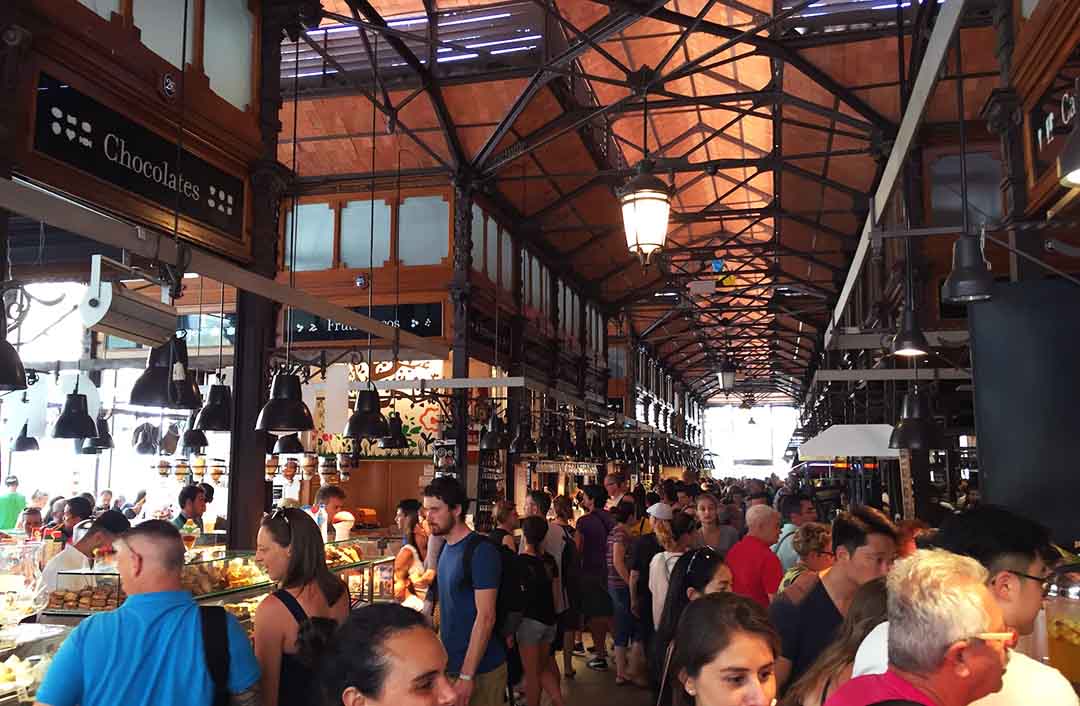
Alcala Gate (Puerta de Alcalá)
The Alcala Gate, or Puerta de Alcalá, is a magnificent neoclassical monument that graces the city center of Madrid, marking a regal threshold adjacent to the entrance of El Parque del Buen Retiro and standing sentinel in the Plaza de la Independencia. This iconic structure was initially envisioned by King Charles III as a grand gateway that would herald the road to the city of Alcalá, symbolizing a welcoming embrace to travelers and citizens alike.
Over the years, the Puerta de Alcalá has transcended its original purpose to become a symbol of Madrid’s rich cultural and historical heritage. It has inspired songs, been the backdrop for countless events, and played a central role in significant cultural traditions. The gate stands not just as a monument of architectural beauty but as a living testament to the stories, celebrations, and milestones that have unfolded in its shadow.
The Puerta de Alcalá is more than a landmark; it’s a narrative in stone, capturing the essence of Madrid’s evolving identity through the ages. It invites visitors and locals to ponder the city’s past, to celebrate its present, and to dream of its future. As you stand before this majestic gateway, you’re not just seeing a piece of history; you’re becoming part of the ongoing story of Madrid, a city that cherishes its traditions while boldly stepping into the future.
Royal Palace (Palacio Real)
The Royal Palace, or Palacio Real, is a monumental testament to Spain’s rich royal heritage and architectural grandeur. Once the official residence of King Carlos III through to King Alfonso XIII, this majestic palace now opens its doors to the public, inviting visitors from around the globe to explore its opulent chambers and intricate histories. Despite the royal family no longer residing within its walls, the Palacio Real remains their official domicile, a symbol of the enduring legacy of Spain’s monarchy.
Every Wednesday, a traditional spectacle unfolds at the palace’s grand entrance: the changing of the guard. This ceremony is a vivid display of historical pageantry, offering a glimpse into the ceremonial customs that have been preserved through the ages. It’s an experience that captivates audiences with its precision and splendor, echoing the grandiosity of royal traditions.
The Palacio Real itself is an architectural marvel. Its vast, white facade exudes elegance and power, commanding respect and admiration from all who behold it. The palace’s design is a masterful blend of artistic styles, showcasing the pinnacle of Spanish architecture and the intricate tastes of the royals who once called it home.
For enthusiasts of architecture and royal history, the Royal Palace is an indispensable visit. It’s not just a journey through the grand living quarters of Spain’s former monarchs; it’s an immersive experience into the art, culture, and history that have shaped Spain. The Palacio Real stands as a proud reminder of the country’s regal past, a must-see landmark that offers endless inspiration and awe.
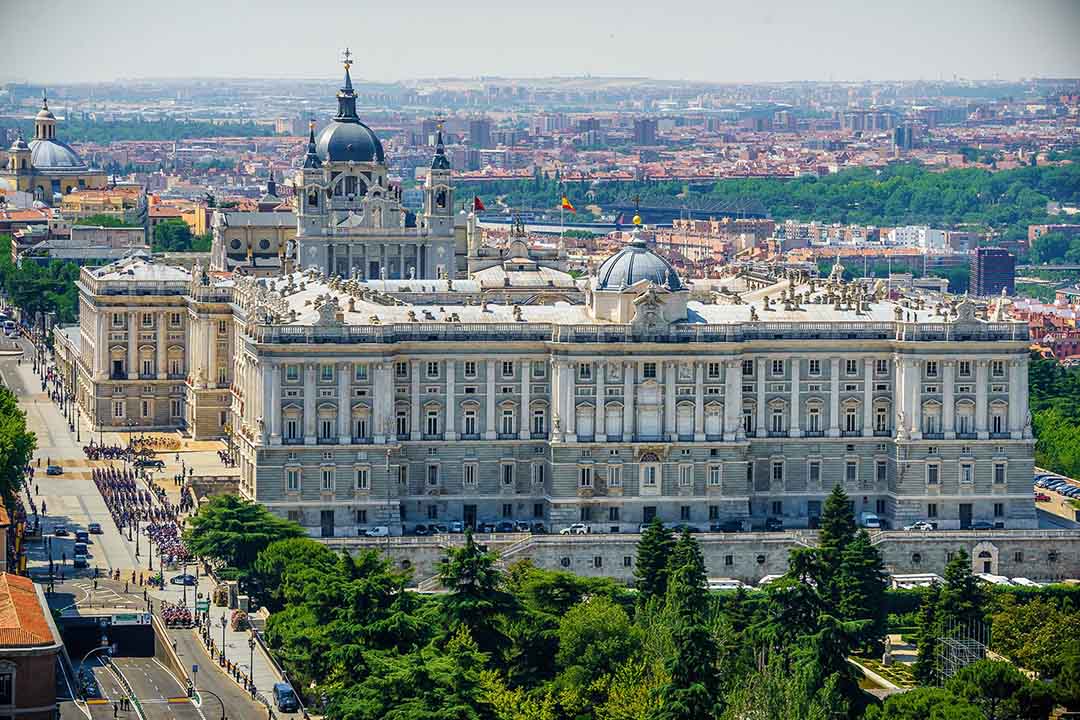
Almudena Cathedral (Catedral de Nuestra Señora la Almudena)
The Catedral de Nuestra Señora la Almudena, or Almudena Cathedral, stands as a testament to the perseverance and evolving vision that have characterized Madrid’s history. Its journey from concept to completion is a narrative filled with challenges, reflecting the tumultuous path it followed through the ages. Initially envisioned by King Philip II, who, upon designating Madrid as the capital of Spain, sought to establish a cathedral befitting the city’s new status. However, this ambition was met with resistance, most notably from the archdiocese of Toledo, leading to prolonged delays that spanned centuries.
The cathedral’s story is further complicated by the Spanish Civil War and debates over its architectural style, which would see its construction process endure numerous pauses and revisions. Despite these obstacles, the resolve to complete the cathedral never waned, and in 1993, Almudena Cathedral was officially completed, marking the end of a centuries-long endeavor.
Today, standing before Almudena Cathedral offers visitors a unique opportunity to connect with Madrid’s rich historical tapestry. The cathedral’s architecture, a blend of classical and modernist styles, serves as a physical representation of its protracted genesis, embodying the diverse influences and eras it has witnessed. To visit Almudena Cathedral is to stand in the presence of resilience, to admire the beauty that arises from persistence, and to celebrate the culmination of Madrid’s enduring spirit to bring its cathedral to life. It’s a truly singular experience that not only showcases architectural achievement but also tells the story of a city’s unyielding aspiration and its ultimate triumph.
Gran Via
Gran Via, affectionately known as Madrid’s “Great Way,” is a vibrant artery that pulses through the heart of the city, encapsulating the essence of Madrid’s dynamic spirit. This iconic boulevard is celebrated not only as a premier destination for high-end shopping but also as a magnificent showcase of early 20th-century architecture, making it one of the city’s most animated and beloved areas.
As you stroll down Gran Via, you’re greeted by a kaleidoscope of sights and sounds that capture the city’s lively urban rhythm. The street is lined with an array of movie theatres, luxurious hotels, sprawling shopping malls, and an assortment of dining venues, each adding its own flavor to the vibrant mosaic of Gran Via. The architectural grandeur of the boulevard is truly a sight to behold, with each building telling its own story of design and history. Notable landmarks such as the Metropolis Building, with its iconic dome and angelic statue; the Telefonica headquarters, heralding the advent of modern telecommunications; and the Edificio Grassy, known for its exquisite façade, stand as testaments to the architectural innovation and aesthetic sensibility of early 20th-century Madrid.
Exploring Gran Via is more than just a walk; it’s an experience that encapsulates the very soul of Madrid. This bustling thoroughfare offers a window into the city’s eclectic character, where tradition and modernity converge in a continuous dance of culture and commerce. Whether you’re indulging in a shopping spree, marveling at the architectural wonders, or simply soaking in the energetic atmosphere, Gran Via promises an exhilarating half-day adventure that embodies the lively essence of Madrid.

